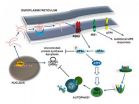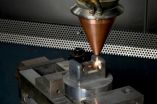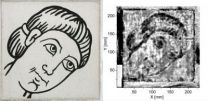(Press-News.org) Short snippets of DNA found in human brain tissue provide new insight into human cognitive function and risk for developing certain neurological diseases, according to researchers from the Departments of Psychiatry and Neuroscience at Mount Sinai School of Medicine. The findings are published in the November 20th issue of PLoS Biology.
There are nearly 40 million positions in the human genome with DNA sequences that are different than those in non-human primates, making the task of learning which are important and which are inconsequential a challenge for scientists. Rather than comparing these sequences strand by strand, Schahram Akbarian, MD, PhD, Professor of Psychiatry and Neuroscience at Mount Sinai School of Medicine, wanted to identify the crucial set of differences between the two genomes by looking more broadly at the chromatin, the structure that packages the DNA and controls how it is expressed.
They found hundreds of regions throughout the human genome which showed a markedly different chromatin structure in neurons in the prefrontal cortex, a brain region that controls complex emotional and cognitive behavior, compared to non-human primates. The findings of the study provide important insights for diseases that are unique to humans such as Alzheimer's disease and autism.
"While mapping the human genome has taught us a great deal about human biology, the emerging field of epigenomics may help us identify previously overlooked or discarded sequences that are key to understanding disease," said Dr. Akbarian. "We identified hundreds of loci that represent untapped areas of study that may have therapeutic potential."
Dr. Akbarian and his research team isolated small snippets of chromatin fibers from the prefrontal cortex. Next, they analyzed these snippets to determine what genetic signals they were expressing. Many of the sequences with human-specific epigenetic characteristics were, until recently, considered to be "junk DNA" with no particular function.
Now, they present new leads on how the human brain has evolved, and a starting point for studying neurological diseases. For example, the sequence of DPP10—a gene critically important for normal human brain development—not only showed distinct human-specific chromatin structures different from other primate brains such as the chimpanzee or the macaque, but the underlying DNA sequence showed some interesting differences from two extinct primates—the Neanderthal and Denisovan, most closely related to our own species and also referred to as 'archaic hominins'.
"Many neurological disorders are unique to human and are very hard as a clinical syndrome to study in animals, such as Alzheimer's disease, autism, and depression," said Dr. Akbarian. "By studying epigenetics we can learn more about those unique pieces of the human genome."
The research team also discovered that several of these chromatin regions appear to physically interact with each other inside the cell nucleus, despite being separated by hundreds of thousands of DNA strands on the genome. This phenomenon of "chromatin looping" appears to control the expression of neighboring genes, including several with a critical role for human brain development.
"There is growing consensus among genome researchers that much of what was previously considered as 'junk sequences' in our genomes indeed could play some sort of regulatory role," said Dr. Akbarian.
This study was supported by grants from the National Institutes of Health. Dr. Akbarian plans to do more epigenetic studies in other areas of the brain to see if there are additional chromatin regions that are unique to humans. They also plan to study the epigenomes of other mammals with highly evolved social behaviors such as elephants.
Dr. Akbarian joined Mount Sinai in July 2012. He is internationally known for his cutting-edge research on the epigenetic mechanisms of psychiatric disorders. He is a widely recognized expert in advanced chromatin tools—many of which were developed in his laboratory—in conjunction with mouse mutagenesis and behavioral models of mental illness to bridge molecular, cellular, and behavioral investigations. He is also a renowned authority on the epigenetic analysis of human brain tissue examined postmortem.
Prior to joining Mount Sinai, Dr. Akbarian was Director of the Brudnick Neuropsychiatric Research Institute. He received his medical and doctorate degrees from the Freie Universitaet Berlin. Dr. Akbarian completed his postdoctoral training in neuroscience at the University of California at Irvine and the Whitehead Institute, and his residency in psychiatry at Massachusetts General Hospital.
### About The Mount Sinai Medical Center
The Mount Sinai Medical Center encompasses both The Mount Sinai Hospital and Mount Sinai School of Medicine. Established in 1968, Mount Sinai School of Medicine is one of the leading medical schools in the United States. The Medical School is noted for innovation in education, biomedical research, clinical care delivery, and local and global community service. It has more than 3,400 faculty in 32 departments and 14 research institutes, and ranks among the top 20 medical schools both in National Institutes of Health (NIH) funding and by US News and World Report.
The Mount Sinai Hospital, founded in 1852, is a 1,171-bed tertiary- and quaternary-care teaching facility and one of the nation's oldest, largest and most-respected voluntary hospitals. In 2011, US News and World Report ranked The Mount Sinai Hospital 14th on its elite Honor Roll of the nation's top hospitals based on reputation, safety, and other patient-care factors. Mount Sinai is one of 12 integrated academic medical centers whose medical school ranks among the top 20 in NIH funding and US News and World Report and whose hospital is on the US News and World Report Honor Roll. Nearly 60,000 people were treated at Mount Sinai as inpatients last year, and approximately 560,000 outpatient visits took place.
For more information, visit http://www.mountsinai.org/.
Find Mount Sinai on:
Facebook: http://www.facebook.com/mountsinainyc
Twitter: @mountsinainyc
YouTube: http://www.youtube.com/mountsinainy
Short DNA strands in the genome may be key to understanding human cognition and diseases
Previously discarded, human-specific 'junk' DNA represents untapped resource in the study of diseases like Alzheimer's and autism
2012-11-21
ELSE PRESS RELEASES FROM THIS DATE:
It takes two to tangle: Wistar scientists further unravel telomere biology
2012-11-21
Chromosomes - long, linear DNA molecules – are capped at their ends with special DNA structures called telomeres and an assortment of proteins, which together act as a protective sheath. Telomeres are maintained through the interactions between an enzyme, telomerase, and several accessory proteins. Researchers at The Wistar Institute have defined the structure of one of these critical proteins in yeast.
Understanding how telomeres keep chromosomes – and by extension, genomes – intact is an area of intense scientific focus in the fields of both aging and cancer. In aging, ...
Pathway identified in human lymphoma points way to new blood cancer treatments
2012-11-21
PHILADELPHIA – A pathway called the "Unfolded Protein Response," or UPR, a cell's way of responding to unfolded and misfolded proteins, helps tumor cells escape programmed cell death during the development of lymphoma.
Research, led by Lori Hart, Ph.D., research associate and Constantinos Koumenis, Ph.D., associate professor,and research division director in the Department of Radiation Oncology, both from the Perelman School of Medicine, University of Pennsylvania, and Davide Ruggero, Ph.D., associate professor, Department of Urology, University of California, San Francisco, ...
University of Tennessee study: Unexpected microbes fighting harmful greenhouse gas
2012-11-21
The environment has a more formidable opponent than carbon dioxide. Another greenhouse gas, nitrous oxide, is 300 times more potent and also destroys the ozone layer each time it is released into the atmosphere through agricultural practices, sewage treatment and fossil fuel combustion.
Luckily, nature has a larger army than previously thought combating this greenhouse gas—according to a study by Frank Loeffler, University of Tennessee, Knoxville–Oak Ridge National Laboratory Governor's Chair for Microbiology, and his colleagues.
The findings are published in the ...
Saving water without hurting peach production
2012-11-21
U.S. Department of Agriculture (USDA) scientists are helping peach growers make the most of dwindling water supplies in California's San Joaquin Valley.
Agricultural Research Service (ARS) scientist James E. Ayars at the San Joaquin Valley Agricultural Sciences Center in Parlier, Calif., has found a way to reduce the amount of water given post-harvest to early-season peaches so that the reduction has a minimal effect on yield and fruit quality. ARS is USDA's principal intramural scientific research agency, and the research supports the USDA priority of promoting international ...
Better protection for forging dies
2012-11-21
Forging dies must withstand a lot. They must be hard so that their surface does not get too worn out and is able to last through great changes in temperature and handle the impactful blows of the forge. However, the harder a material is, the more brittle it becomes - and forging dies are less able to handle the stress from the impact. For this reason, the manufacturers had to find a compromise between hardness and strength. One of the possibilities is to surround a semi-hard, strong material with a hard layer. The problem is that the layer rests on the softer material and ...
CDC and NIH survey provides first report of state-level COPD prevalence
2012-11-21
The age-adjusted prevalence of chronic obstructive pulmonary disease (COPD) varies considerably within the United States, from less than 4 percent of the population in Washington and Minnesota to more than 9 percent in Alabama and Kentucky. These state-level rates are among the COPD data available for the first time as part of the newly released 2011 Behavioral Risk Factor Surveillance System (BRFSS) survey.
"COPD is a tremendous public health burden and a leading cause of death. It is a health condition that needs to be urgently addressed, particularly on a local level," ...
Detective work using terahertz radiation
2012-11-21
It was a special moment for Michael Panzner of the Fraunhofer Institute for Material and Beam Technology IWS in Dresden, Germany and his partners: in the Dresden Hygiene Museum the scientists were examining a wall picture by Gerhard Richter that had been believed lost long ago. Shortly before leaving the German Democratic Republic the artist had left it behind as a journeyman's project. Then, in the 1960s, it was unceremoniously painted over. However, instead of being interested in the picture, Panzer was far more interested in the new detector which was being used for ...
Architecture of rod sensory cilium disrupted by mutation
2012-11-21
HOUSTON – (Nov. 22, 2012) – Using a new technique called cryo-electron tomography, two research teams at Baylor College of Medicine (www.bcm.edu) have created a three-dimensional map that gives a better understanding of how the architecture of the rod sensory cilium (part of one type of photoreceptor in the eye) is changed by genetic mutation and how that affects its ability to transport proteins as part of the light-sensing process.
Almost all mammalian cells have cilia. Some are motile and some are not. They play a central role in cellular operations, and when they ...
New evidence of dinosaurs' role in the evolution of bird flight
2012-11-21
Academics at the Universities of Bristol, Yale and Calgary have shown that prehistoric birds had a much more primitive version of the wings we see today, with rigid layers of feathers acting as simple airfoils for gliding.
Close examination of the earliest theropod dinosaurs suggests that feathers were initially developed for insulation, arranged in multiple layers to preserve heat, before their shape evolved for display and camouflage.
As evolution changed the configuration of the feathers, their important role in the aerodynamics and mechanics of flight became more ...
New Informatics and Bioimaging Center combines resources, expertise from UMD, UMB
2012-11-21
ADELPHI, Md. – A new center that combines advanced computing resources at the University of Maryland, College Park (UMD) with clinical data and biomedical expertise at the University of Maryland, Baltimore (UMB) could soon revolutionize the efficiency and effectiveness of health care in the state of Maryland and beyond.
The Center for Health-related Informatics and Bioimaging (CHIB) announced today joins computer scientists, life scientists, engineers, physicists, biostatisticians and others at the College Park campus with imaging specialists, physicians, clinicians ...
LAST 30 PRESS RELEASES:
Why are there so many Nordic mediators?
Young shark species more vulnerable to extinction
Mobile fetal heart monitoring linked to fewer newborn deaths in Tanzania
Bluey’s dad offered professorial chair in archaeology at Griffith University
Beyond small data limitations: Transfer learning-enabled framework for predicting mechanical properties of aluminum matrix composites
Unveiling non-thermal catalytic origin of direct current-promoted catalysis for energy-efficient transformation of greenhouse gases to valuable chemicals
Chronic breathlessness emerging as a hidden strain on hospitals
Paleontologists find first fossil bee nests made inside fossil bones
These fossils were the perfect home for ancient baby bees
Not everyone reads the room the same. A new study examines why.
New research identifies linked energy, immune and vascular changes in ME/CFS
Concurrent frailty + depression likely boost dementia risk in older people
Living in substandard housing linked to kids’ missed schooling and poor grades
Little awareness of medical + psychological complexities of steroid cream withdrawal
Eight in 10 trusts caring for emergency department patients in corridors, finds BMJ investigation
NASA’s Webb telescope finds bizarre atmosphere on a lemon-shaped exoplanet
The gut bacteria that put the brakes on weight gain in mice
Exploring how patients feel about AI transcription
Category ‘6’ tropical cyclone hot spots are growing
Video: Drivers struggle to multitask when using dashboard touch screens, study finds
SLU research shows surge in alcohol-related liver disease driving ‘deaths of despair’
Rising heat reshapes how microbes break down microplastics, new review finds
Roots reveal a hidden carbon pathway in maize plants
Membrane magic: FAMU-FSU researchers repurpose fuel cells membranes for new applications
UN Member States pledge to increase access to diagnosis and inhaled medicines for the 480 million people living with COPD
Combination therapy shows potential to treat pediatric brain cancer ATRT
Study links seabird nesting to shark turf wars in Hawai‘i
Legal sports betting linked to sharp increases in violent crime, study finds
Breakthrough AI from NYUAD speeds up discovery of life-supporting microbes
New Eva Mayr-Stihl Foundation funding initiative boosts research at University of Freiburg on adaptation of forests to global change
[Press-News.org] Short DNA strands in the genome may be key to understanding human cognition and diseasesPreviously discarded, human-specific 'junk' DNA represents untapped resource in the study of diseases like Alzheimer's and autism


